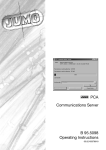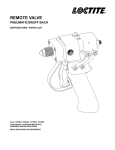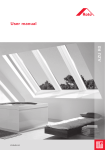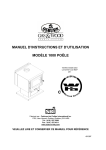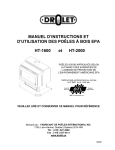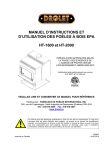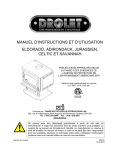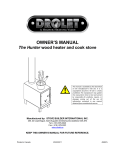Download Mr. Heater MH40PH Specifications
Transcript
INSTRUCTIONS AND PARTS LIST RETAIN THESE INSTRUCTIONS FOR FUTURE REFERENCE. INSTALLER – LEAVE THESE INSTRUCTIONS WITH THE CONSUMER PATIO HEATER MODELS: MH40PH LP GAS-FIRED OUTDOOR PATIO HEATER 40,000 BTU/HR Specifications Type of Gas For use with Propane Only Input rating 40,000 Btu/Hr Manifold Pressure 10.7” Water Column Regulator Pressure 11.0” Water Column Orifice Size 1.95mm Maximum Supply Pressure 150psig Minimum inlet supply pressure 5psig YOUR SAFETY IS IMPORTANT TO YOU AND TO OTHERS SO PLEASE READ THESE INSTRUCTIONS BEFORE YOU OPERATE THIS HEATER. GENERAL HAZARD WARNING: IMPROPER INSTALLATION, ADJUSTMENT, ALTERATION. SERVICE, OR MAINTENANCE CAN CAUSE INJURY OR PROPERTY DAMAGE. READ THE INSTALLATION, OPERATING AND MAINTENANCE INSTRUCTIONS THOROUGHLY BEFORE INSTALLING OR SERVICING THIS EQUIPMENT. WARNING: FIRE, BURN, INHALATION, AND EXPLOSION HAZARD. KEEP SOLID COMBUSTIBLES, SUCH AS BUILDING MATERIALS, PAPER OR CARDBOARD, A SAFE DISTANCE AWAY FROM THE HEATER AS RECOMMENDED BY THE INSTRUCTIONS. NEVER USE THE HEATER IN SPACES WHICH DO OR MAY CONTAIN VOLATILE OR AIRBORNE COMBUSTIBLES, OR PRODUCTS SUCH AS GASOLINE, PAINT THINNER, DUST PARTICLES OR UNKNOWN CHEMICALS. ENERCO / MR. HEATER 4560 W. 160th St., CLEVELAND, OHIO 44135 FAX: 1-800-321-0552 TEL: 1-800-251-0001 Page 1 of 11 0253700 - 0296656 06/08 Rev A WARNING: FOR OUTDOOR USE ONLY FOR YOUR SAFETY Do not store or use gasoline or other flammable vapors and liquids in the vicinity of this or any other appliance. CALIFORNIA PROPOSITION 65 – WARNING Fuels used in gas or oil-fired appliance and the products of combustion of such fuels, contain chemicals known to the State of California to cause cancer, birth defects and other reproductive harm. California Health & Safety Code Sec. 25249.6 FOR YOUR SAFETY If you smell gas: 1. Shut off gas to the appliance. 2. Extinguish and open flame. 3. If odor continues, immediately call you gas supplier. Safety Precautions: • Care must be taken for the supervision of children in the vicinity of an operating or hot heater. • Due to the high surface temperatures adults and children must observe clearances to avoid burns or clothing ignition. • Check the heater thoroughly for damage. DO NOT operate a damaged heater. • The heater should be inspected before each use, and at least annually by a qualified service person. • Do Not Modify the heater or operate a heater, which has been modified from its original condition. • Do Not operate a heater that is not fully assembled. • Use only with propane gas. • Use only Vapor withdraw propane cylinder. • Disconnect the propane cylinder from the heater when not in use. • Never use the heater if the ballast weight is not assembled onto the base. The base must be weighted to avoid tipping. • Use only the regulator provided with the heater. Never connect heater to an unregulated gas supply. • This heater is for outdoor use only; even so make sure that there is ample fresh air ventilation. DO NOT use in buildings, garages, or other enclosed spaces. • If at any time gas odor is detected, IMMEDIATELY DISCONTINUE operation until the source of gas has been located and corrected. See Fuel Safety Precautions for more details about smelling odors. • Install the heater such that it is not directly exposed to water spray, rain and or dripping water or wind. Page 2 of 11 • • • • • • • • • • Always maintain minimum clearances to people or combustibles (like paper) of: Horizontal from dome (360o) – 3ft; Ceiling – 3ft. Operate only on a level stable surface. Do not move, handle or service while hot or burning. Do not use heater in a windy condition where wind speed exceeds 10 mph. Use only in accordance with local codes. Do not hang or attach clothing or any other combustibles from, on or near heater. Check control compartment burners and circulation air passageways for free air passage; make sure that there are no obstructions. These areas are a common location for spider webs, which can present a dangerous condition, damage the heater and render it unsafe for use. The heater must be checked if any of the following conditions exist: a. Gas smell along with predominate yellow tipping of the burner flames. b. Heater does not reach temperature. c. Uneven burner glow. d. Burner makes popping noises during normal use, other than during shutdown. Only a qualified service person should install and repair this heater. Stainless steel emitter and gas valve should not be cleaned or painted. The reflector and control cover may be cleaned with a non-corrosive / non-combustible solution, but not painted. After initial assembly and after every cylinder replacement, all gas connection should be checked for leaks with a soap and water solution, NEVER USE FLAME 06/08 Rev A Fuel Safety Precautions WARNING Asphyxiation Hazard Do not use this heater for heating human living quarters. Do not use in unventilated areas. The flow of combustion and ventilation air must not be obstructed. Proper ventilation air must be provided to support the combustion air requirements of the heater being used. Refer to the specification section of the heater's Manual, FUEL GAS ODOR ---------------LP gas and natural gas have man-made odorants added specifically for detection of fuel gas leaks. If a gas leak occurs you should be able to smell the fuel gas. Since Propane (LP) is heavier than air you should smell for the gas odor low to the floor. ANY GAS ODOR IS YOUR SIGNAL TO GO INTO IMMEDIATE ACTION! Do not take any action that could ignite the fuel gas. Do not operate any electrical switches. Do not pull any power supply or extension cords. Do not light matches or any other source of flame. Do not use your telephone. heater data plate, or contact the ENERCO / MR. HEATER to determine combustion air ventilation requirements of the heater. Lack of proper ventilation air will lead to improper combustion. Improper combustion can lead to carbon monoxide poisoning leading to serious injury or death. Symptom of carbon monoxide poisoning can include headaches dizziness and difficulty in breathing . Learn to recognize the odor of propane (LP) gas and natural gas. Local propane (LP) gas dealers will be more than happy to give you a scratch and sniff pamphlet. Use it to become familiar with the fuel gas odor. Smoking can decrease your ability to smell. Being around an odor for a period of time can affect your sensitivity to that particular odor. Odors present in animal confinement buildings can mask fuel gas odor. The odorant in propane (LP) gas and natural gas is colorless and the intensity of its odor can fade under some circumstances. If there is an underground leak, the movement of gas through the soil can filter the odorant. Propane (LP) gas odor may differ in intensity at different levels. Since Propane (LP) gas is heavier than air, there may be more odor at lower levels. Get everyone out of the building and away from the area immediately. Close all propane (LP) gas tank or cylinder fuel supply valves, or the main fuel supply valve located at the meter if you use natural gas. Always be sensitive to the slightest gas odor. If you continue to detect any gas odor, no matter how small, treat it as a serious leak. Immediately go into action as discussed previously Propane (LP) gas is heavier than air and may settle in low areas. When you have reason to suspect a propane leak, keep out of all low areas. ATTENTION - CRITICAL POINTS TO REMEMBER! Use your neighbor's phone and call your fuel gas supplier and your fire department. Do not re-enter the building or area. Propane (I-P) gas has a distinctive odor. Learn to recognize these odors. (Reference Fuel Gas Odor and Odor Fading sections above. Stay out of the building and away from the area until declared safe by the firefighters and your fuel gas supplier. Even If you are not property trained in the service and repair of the heater, ALWAYS be consciously aware of the odors of propane (LP) gas and natural gas. FINALLY, let the fuel gas service person and the firefighters check for escaped gas. Have them air out the building and area before you return. Properly trained service people must repair the leak, check for further leakages, and them relight the appliance for you. If you have not been properly trained in repair and service of propane (LP) gas then do not attempt to light heater, perform service or repairs, or make any adjustments to the heater on the propane (LP) gas fuel system. A periodic sniff test around the heater or at the heater's joints; i.e. hose, connections, etc., is a good safety practice under any conditions. If you smell even a small amount of gas, CONTACT YOUR FUEL GAS SUPPLIER IMMEDIATELY. DO NOT WAIT ODOR FADING - NO ODOR DETECTED--- Some people cannot smell well. Some people cannot smell the odor of the man-made chemical added to propane (LP) or natural gas. You must determine if you can smell the odorant in these fuel gases. \\Commserv\Users\EGI_Shared\Engineering\Labels & Manuals WIP\MH40PH\MH40PH Manual.doc Page 3 of 11 06/08 Rev A ASSEMBLY INSTRUCTIONS. Removing Heater from Package: 1. Remove heater, reflector from carton. 2. Remove all shipping packaging from heater components. 3. Retain all packaging material and carton, until heater warranty has expired. Any warranty returns require original packaging and carton. 4. Check heater for any shipping damage. If any is found, immediately contact and return heater to dealer / distributor where purchased. Step 1: Remove all components from package and inspect parts. Packaging includes: Nut & Bolt Pack Containing: 4pcs--3/16”-24x3/8” screws 12pcs--1/4”-20x3/4” bolts 12pcs--1/4”-20 nuts 24pcs--1/4” flat washers 12pcs--1/4” lock washers 4pcs--Pan head screws 4--Pan head Washers 3pcs--1/4”-20x1/2” bolts 3pcs--1/4”-20x1/2” bolts (stainless steel) 3pcs--5/16”-18 round head nuts 6pcs-5/16” flat washers Loose Items: 1-Dome 1-Emitter 1-Burner Assembly 1-Post 1-Gas Line 3-Legs 1-Post support 1-Cylinder Cap 1-Base 1-Chain 1-Back Cylinder Cover 1-Front Cylinder Cover \\Commserv\Users\EGI_Shared\Engineering\Labels & Manuals WIP\MH40PH\MH40PH Manual.doc Page 4 of 11 06/08 Rev A Step 2: Tighten the 3 nuts on the emitter top. Step 3: Attach Emitter Assembly to Burner Assembly (4-screws 3/16"-24×3/8") Step 4: Attach 3 Legs to Post Support (6 bolts 1/4"-20× Step 5: (If your patio heater has Wheels, please 3/4"& 12 flat washers & 6 lock washers & 6 nuts) assemble the wheels as Attachment 2, before Step 5). Attach 3 Legs/Post Support Assembly to Base (6 bolts 1/4"-20×3/4"& 12 flat washers & 6 lock washers & 6 nuts) Step 6: Install Post onto Post Support and attach it (3 Step 7: Attach Cylinder Back Cover to Legs (4-pan bolts 1/4"-20×1/2" & 3 flat washers) head screws, 4-flat washers) \\Commserv\Users\EGI_Shared\Engineering\Labels & Manuals WIP\MH40PH\MH40PH Manual.doc Page 5 of 11 06/08 Rev A Step 8: Place Cylinder Cap onto Post pull into place. Step 9: Assemble the Gas Line to the Burner Assembly and tighten. Step 10: Leak Test #1: Step 11: (please read the NOTE) *Mix a leak check solution (1-part liquid dishwashing Carefully insert the Gas Line into the Post. detergent to 3-parts water). Take great care not damage the flare fitting on the Gas *Connect the Hose and Regulator Assembly to the Gas Line that will connect to the Hose and Regulator. Line and tighten. Then connect the Regulator to the propane cylinder. *Apply several drops of the leak check solution to the gas connection at the burner assembly. *Make sure that the heater control knob is turned “OFF”. *”Open” the Propane Cylinder Valve. *If bubbles appear at the connection, there is a leak and it must be tightened until no bubbles appear. MAKE SURE THERE IS NO LEAKS. *”Close” the Propane Cylinder Valve, then disconnect the Hose and regulator Assembly from the Propane Cylinder and the Gas Line **NOTE: If your patio heater has a Bar Table, please assemble the table as Attachment 1, before Step 11. \\Commserv\Users\EGI_Shared\Engineering\Labels & Manuals WIP\MH40PH\MH40PH Manual.doc Page 6 of 11 06/08 Rev A Step 12: Attach Burner Assembly to the Post (3 bolts 1/4"-20×1/2" & 3 flat washers) Step 13: Attach Dome to the Emitter (3 round-head nuts M8 & 6 flat washers) Step 14: Connect the Hose and Regulator Assembly to the Flare Fitting on the Gas Line and tighten. Step 15: Leak Test #2: *Attach the regulator to the Propane Cylinder. *Apply several drops of the Leak Check Solution (Step 10) to the hose / gas line connection. *Make sure the Heater Control Knob is “OFF”. **”Open” the Propane Cylinder Valve. *If bubbles appear at the connection, there is a leak and it must be tightened until no bubbles appear. MAKE SURE THERE IS NO LEAKS. *”Close” the Propane Cylinder Valve, then disconnect the Hose and regulator Assembly from the Propane Cylinder and the Gas Line \\Commserv\Users\EGI_Shared\Engineering\Labels & Manuals WIP\MH40PH\MH40PH Manual.doc Page 7 of 11 06/08 Rev A Step 16: Place the Propane Cylinder into the Base. Then lift the cylinder Cap Support, to hold the cap in position. Attach the Front Cover to the Back Cover. Then lower Cap. Gas Requirements: The heater comes with a regulator for hook-up to a standard propane gas cylinder set up for vapor withdrawal (operated with the cylinder vertical). The gas cylinder must be constructed and marked in accordance with specifications of the U.S. Department of Transportation for propane cylinders. Never connect the heater to an unregulated cylinder. The heater is shipped from the factory for use with propane never substitute gases. To Light: CAUTION: When the heater is to be operated in the presence of other people the user is responsible for properly acquainting those present with safety precautions, and other hazards involved. 4. Fuel Connection: 1. Use a 20-pound (5-gallon) vapor withdrawal propane cylinder. Not supplied with the heater. 2. Place the cylinder in the heater base with the valve accessible. 3. Connect the POL fitting of the hose & regulator assembly to the propane cylinder by rotating the plastic POL nut clockwise onto the propane cylinder’s valve outlet and securely tighten. 4. Make sure that the safety valve is turned off then open the cylinder’s valve and check all gas connection with a soap and water solution. DO NOT USE A FLAME. The gas connections to check include those in the heater base and the connections in the burner assembly. • 1. 2. 3. 5. 6. 7. 8. Caution: Never leave heater operating unattended. Remove the Cylinder cover on the base. Make sure that all gas connections where checked with a soap and water solution before igniting heater, as described in the fuel connection section of this manual. Fully open the valve on the propane cylinder. Turn safety gas control knob to “pilot” position. Push in and hold the gas control knob then push and release the ignition button repeatedly until there is a flame at the pilot. If the ignition button does not work the pilot may be lit using a match through the access hole, found under the emitter base. Keep the control knob depressed for at least 30 seconds after pilot ignition then release control knob. Turn the burner on to maximum rate then reduce to desired burner setting. Replace the cylinder cover on the base to cover the propane cylinder. • Caution: White smoke may appear around the emitter screen during the first few minutes of the initial burning. Relight After Shutdown: 1. Turn the gas control knob to “OFF” position. 2. Wait 5 minutes. 3. Restart following “To Light” procedure. \\Commserv\Users\EGI_Shared\Engineering\Labels & Manuals WIP\MH40PH\MH40PH Manual.doc Page 8 of 11 06/08 Rev A To Shutdown: 1. Turn gas control knob clockwise to “OFF” position. o Caution: Cylinder removal should only be undertaken when heater is cool to the touch. 2. If the heater is not to be used, securely close the valve at the propane cylinder. 3. Do not attempt to relight the heater for at least 5 minutes after the propane cylinder valve has been closed. Storage: 3. 4. • Never store a propane cylinder inside a building or in the vicinity of any gas, oil or solid fuel-burning appliance. Cylinder must be disconnected and removed from the heater base assembly and stored in accordance with local, state and federal codes. In the absents of such codes, install in accordance with American National Standard (ANSI) / National Fire Protection Association (NFPA) publication “Standard for the Storage and Handling of Liquefied Petroleum Gases ANSI/NFPA 58-latest edition Maintenance: 1. A qualified person should inspect the heater before each use, and at least annually. 2. Before each use, check the POL fitting for any damage, and replace if any damage is found. Safety: BEWARE OF SPIDERS CAUTION: BURNER TUBES MUST BE INSPECTED AND CLEANED BEFORE EACH USE. Spiders and small insects occasionally spin webs or make nests in the burner tubes and or orifices during warehousing and transit. These webs or nests can lead to a gas flow obstruction, which could result in a fire in and around the burner tube. This type of fire is know as FLASHBACK and can cause serious damage to your patio heater and creates an unsafe operating condition for the user. Although an obstructed burner tube is not the only cause of FLASHBACK, it is the most common cause, and frequent inspections and cleaning of the burner tube is necessary. Turn off the propane vapor supply at the cylinder when the heater is not to be used. Inspect and clean the air circulation, combustion and ventilation passageways of the heater, burner, burner venturi and main burner orifice at least once a year or immediately upon indication of any of the following systems: • Flashback. • Smell of aldehydes. • Predominate yellow fames. • Excessive popping noises during operation. • Diminished and uneven emitter glow. 5. When the heater is to be stored indoors, the connection between the LP-gas supply cylinder and the heater must be disconnected and the cylinder removed from the heater and stored in accordance with chapter 5 of the standard for “Storage and Handling of Liquefied Petroleum Gases” ANSI/NFPA 58. Only recoat those portions of the heater (post, base assembly) with high temperature (1200oF) paint. Never paint the reflector, or any portion of the stainless steel burner assembly. The reflector may be cleaned with a non-corrosive / non-combustible product. Warning: Local codes for installation of propane systems may very considerably. Therefore, ask your local propane supplier for advice on propane system installation in your particular area. In the absence of local codes, install in accordance with American National Standards Institute (ANSI) / National Fire Protection Association (NFPA) publication “Standard for the Storage and Handling of Liquefied Petroleum Gases ANSI/NFPA 58 and National Fuel Gas Code ANSI Z223.1.” Your propane supplier, fire marshal or library should have a copy. The propane supply system must be arranged for vapor withdrawal. Propane cylinders must be secured in the base and changed in the upright position to keep them from falling or being knocked over. \\Commserv\Users\EGI_Shared\Engineering\Labels & Manuals WIP\MH40PH\MH40PH Manual.doc Page 9 of 11 06/08 Rev A Servicing: A hazardous condition may result if a heater is used that has been modified or is not functioning properly. When the heater is working properly: • The flame is contained within the heater. • The flame is essentially blue. • There is no strong disagreeable odor, eye burning or other physical discomfort. • There is no smoke or soot internal or external to the heater. • There is no unplanned or unexplained shutdown of the heater. • There is no Flashback. • There are no excessive popping noises during operation. • There is no diminished and uneven emitter glow. The parts list shows the heater as it was constructed. Do not use a heater, which is different from that shown. In this regard, only the cylinder connections and regulator supplied with the heater. Do not use alternative parts. For this heater the regulator is set for 11.0” water column outlet pressure. If there is any uncertainty about the regulator setting, have it checked. although in reality it might endanger the heater or the persons operating the heater. The heater should be serviced only by a trained, experienced service person. Read the section on “Servicing” before ordering parts. For parts orders, contact us at TEL: 1-800-251-0001 FAX: 1-800-321-0552 ENERCO / MR. HEATER 4560 W. 160th St., CLEVELAND, OHIO 44135 Warranty: Warranty information may be obtained at TEL: 1-800-251-0001 FAX: 1-800-321-0552 You may obtain in-warranty or out-of-warranty service by returning the heater postage prepaid to: ENERCO / MR. HEATER 4560 W. 160th St., CLEVELAND, OHIO 44135 In-warranty products returned to the service department will be repaired with no change for either parts or labor and will be returned to you freight prepaid. Please include a brief statement indicating: A heater that is not working properly must be repaired, but only by a trained, experienced service person. Contact the factory for the service center nearest you. Instructions for Ordering Parts: All parts orders must show heater model number, item number, part number, and description. We recommend that only parts supplied by the manufacture be used on this unit. A locally purchased part may appear to be identical, • Problem for repair • Date of purchase • Place of purchase • Serial Number • Proof of purchase. Out-of-warranty products returned to the service department will be repaired with a charge for parts and labor and will be returned to you freight collect. \\Commserv\Users\EGI_Shared\Engineering\Labels & Manuals WIP\MH40PH\MH40PH Manual.doc Page 10 of 11 06/08 Rev A \\Commserv\Users\EGI_Shared\Engineering\Labels & Manuals WIP\MH40PH\MH40PH Manual.doc Page 11 of 11 06/08 Rev A 06/08 Rev A













